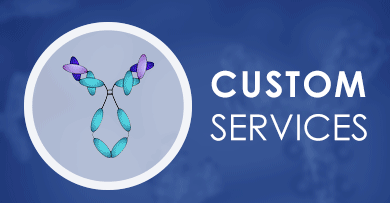+ Filter
 Loading...
Loading...

LCP1
 Loading...
Loading...Anti-LCP1 Products
- Recombinant Human Anti-LCP1 Soluble TCR (GG7) (KIH) (VS-0622-YF6698)
-
- Species Reactivity: Human
- Epitope: NLFNRYPAL
- MHC: HLA class I
- Recombinant Human Anti-LCP1 Soluble TCR (JH2) (KIH) (VS-0622-YF6699)
-
- Species Reactivity: Human
- Epitope: NLFNRYPAL
- MHC: HLA class I
- Recombinant Human Anti-LCP1 Soluble TCR (KA5) (KIH) (VS-0622-YF6700)
-
- Species Reactivity: Human
- Epitope: NLFNRYPAL
- MHC: HLA class I
- Recombinant Human Anti-LCP1 Soluble TCR (LA4) (KIH) (VS-0622-YF6701)
-
- Species Reactivity: Human
- Epitope: NLFNRYPAL
- MHC: HLA class I
- Recombinant Human Anti-LCP1 Soluble TCR (LC2) (KIH) (VS-0622-YF6702)
-
- Species Reactivity: Human
- Epitope: NLFNRYPAL
- MHC: HLA class I
- Recombinant Human Anti-LCP1 Soluble TCR (MC9) (KIH) (VS-0622-YF6703)
-
- Species Reactivity: Human
- Epitope: NLFNRYPAL
- MHC: HLA class I
- Recombinant Human Anti-LCP1 Soluble TCR (LA4) (C-Cys) (VS-0622-YF3993)
-
- Species Reactivity: Human
- Epitope: NLFNRYPAL
- MHC: HLA class I
- Recombinant Human Anti-LCP1 Soluble TCR (LC2) (C-Cys) (VS-0622-YF3994)
-
- Species Reactivity: Human
- Epitope: NLFNRYPAL
- MHC: HLA class I
- Recombinant Human Anti-LCP1 Soluble TCR (MC9) (C-Cys) (VS-0622-YF3995)
-
- Species Reactivity: Human
- Epitope: NLFNRYPAL
- MHC: HLA class I
- Recombinant Human Anti-LCP1 Soluble TCR (NA7) (C-Cys) (VS-0622-YF3996)
-
- Species Reactivity: Human
- Epitope: NLFNRYPAL
- MHC: HLA class I
- Recombinant Human Anti-LCP1 Soluble TCR (NB2) (C-Cys) (VS-0622-YF3997)
-
- Species Reactivity: Human
- Epitope: NLFNRYPAL
- MHC: HLA class I
- Recombinant Human Anti-LCP1 Soluble TCR (AE1) (KIH) (VS-0622-YF6697)
-
- Species Reactivity: Human
- Epitope: NLFNRYPAL
- MHC: HLA class I
- Recombinant Human Anti-LCP1 Soluble TCR (NA7) (ZIP-Fos/ZIP-Jun) (VS-0622-YF1288)
-
- Species Reactivity: Human
- Epitope: NLFNRYPAL
- MHC: HLA class I
- Recombinant Human Anti-LCP1 Soluble TCR (NB2) (ZIP-Fos/ZIP-Jun) (VS-0622-YF1289)
-
- Species Reactivity: Human
- Epitope: NLFNRYPAL
- MHC: HLA class I
- Recombinant Human Anti-LCP1 Soluble TCR (AE1) (C-Cys) (VS-0622-YF3989)
-
- Species Reactivity: Human
- Epitope: NLFNRYPAL
- MHC: HLA class I
- Recombinant Human Anti-LCP1 Soluble TCR (GG7) (C-Cys) (VS-0622-YF3990)
-
- Species Reactivity: Human
- Epitope: NLFNRYPAL
- MHC: HLA class I
- Recombinant Human Anti-LCP1 Soluble TCR (JH2) (C-Cys) (VS-0622-YF3991)
-
- Species Reactivity: Human
- Epitope: NLFNRYPAL
- MHC: HLA class I
- Recombinant Human Anti-LCP1 Soluble TCR (KA5) (C-Cys) (VS-0622-YF3992)
-
- Species Reactivity: Human
- Epitope: NLFNRYPAL
- MHC: HLA class I
- Recombinant Human Anti-LCP1 Soluble TCR (GG7) (ZIP-Fos/ZIP-Jun) (VS-0622-YF1282)
-
- Species Reactivity: Human
- Epitope: NLFNRYPAL
- MHC: HLA class I
- Recombinant Human Anti-LCP1 Soluble TCR (JH2) (ZIP-Fos/ZIP-Jun) (VS-0622-YF1283)
-
- Species Reactivity: Human
- Epitope: NLFNRYPAL
- MHC: HLA class I
- Recombinant Human Anti-LCP1 Soluble TCR (KA5) (ZIP-Fos/ZIP-Jun) (VS-0622-YF1284)
-
- Species Reactivity: Human
- Epitope: NLFNRYPAL
- MHC: HLA class I
- Recombinant Human Anti-LCP1 Soluble TCR (LA4) (ZIP-Fos/ZIP-Jun) (VS-0622-YF1285)
-
- Species Reactivity: Human
- Epitope: NLFNRYPAL
- MHC: HLA class I
- Recombinant Human Anti-LCP1 Soluble TCR (LC2) (ZIP-Fos/ZIP-Jun) (VS-0622-YF1286)
-
- Species Reactivity: Human
- Epitope: NLFNRYPAL
- MHC: HLA class I
- Recombinant Human Anti-LCP1 Soluble TCR (MC9) (ZIP-Fos/ZIP-Jun) (VS-0622-YF1287)
-
- Species Reactivity: Human
- Epitope: NLFNRYPAL
- MHC: HLA class I
- Human Anti-LCP1 Recombinant Soluble TCR (LA4) (scTCR-551ZP-S(P))
-
- Species Reactivity: Human
- Epitope: NLFNRYPAL
- MHC: HLA class I
- Human Anti-LCP1 Recombinant Soluble TCR (LC2) (scTCR-552ZP-S(P))
-
- Species Reactivity: Human
- Epitope: NLFNRYPAL
- MHC: HLA class I
- Human Anti-LCP1 Recombinant Soluble TCR (MC9) (scTCR-553ZP-S(P))
-
- Species Reactivity: Human
- Epitope: NLFNRYPAL
- MHC: HLA class I
- Human Anti-LCP1 Recombinant Soluble TCR (NA7) (scTCR-554ZP-S(P))
-
- Species Reactivity: Human
- Epitope: NLFNRYPAL
- MHC: HLA class I
- Human Anti-LCP1 Recombinant Soluble TCR (NB2) (scTCR-555ZP-S(P))
-
- Species Reactivity: Human
- Epitope: NLFNRYPAL
- MHC: HLA class I
- Recombinant Human Anti-LCP1 Soluble TCR (AE1) (ZIP-Fos/ZIP-Jun) (VS-0622-YF1281)
-
- Species Reactivity: Human
- Epitope: NLFNRYPAL
- MHC: HLA class I
-
- Species Reactivity: Human
- Application: ICC, IF, IHC-Fr, IP, WB
-
- Derivation: Camelid
- Species Reactivity: Human
- Type: ADCC enhanced antibody
- Recombinant Human Anti-LCP1 Soluble TCR (NA7) (KIH) (VS-0622-YF6704)
-
- Species Reactivity: Human
- Epitope: NLFNRYPAL
- MHC: HLA class I
- Recombinant Human Anti-LCP1 Soluble TCR (NB2) (KIH) (VS-0622-YF6705)
-
- Species Reactivity: Human
- Epitope: NLFNRYPAL
- MHC: HLA class I
-
- Derivation: Rabbit
- Species Reactivity: Human
- Type: Rabbit IgG
- Application: WB, IHC, FC
- AbPlus™ Anti-LCP1 Magnetic Beads (VS-0724-YC1149) (VS-0724-YC1149)
-
- Target: LCP1
- Target Species: Human
- Application: IP, Protein Purification
- Human Anti-LCP1 Recombinant Soluble TCR (AE1) (scTCR-547ZP-S(P))
-
- Species Reactivity: Human
- Epitope: NLFNRYPAL
- MHC: HLA class I
- Human Anti-LCP1 Recombinant Soluble TCR (GG7) (scTCR-548ZP-S(P))
-
- Species Reactivity: Human
- Epitope: NLFNRYPAL
- MHC: HLA class I
- Human Anti-LCP1 Recombinant Soluble TCR (JH2) (scTCR-549ZP-S(P))
-
- Species Reactivity: Human
- Epitope: NLFNRYPAL
- MHC: HLA class I
- Human Anti-LCP1 Recombinant Soluble TCR (KA5) (scTCR-550ZP-S(P))
-
- Species Reactivity: Human
- Epitope: NLFNRYPAL
- MHC: HLA class I
-
- Derivation: Mouse
- Species Reactivity: Human
- Type: Mouse IgG1, κ
- Application: WB, IP, IF, IHC, ELISA
- Anti-Human LCP1 Recombinant Antibody (TAB-487CL)
-
- Derivation: Camelid
- Species Reactivity: Human
- Type: Antibody
- Recombinant Anti-human LCP1 VHH Single Domain Antibody (NAB-801-sdAb)
-
- Species Reactivity: Human
- Type: Llama VHH
- Application: WB, IP, ICC, FC, FA
- Anti-Human LCP1 VHH Single Domain Antibody (TAB-0071CL-VHH) (TAB-0071CL-VHH)
-
- Derivation: Phage display library
- Type: Single domain antibody
- Application: ELISA, FC
- Anti-Human LCP1 VHH Single Domain Antibody (TAB-0072CL-VHH) (TAB-0072CL-VHH)
-
- Derivation: Phage display library
- Type: Single domain antibody
- Application: ELISA, FC
- Anti-Mouse LCP1 Immunohistochemistry Kit (VS-0525-XY3966)
-
- Species Reactivity: Human, Mouse, Rat
- Target: LCP1
- Application: IHC
- Rabbit Anti-LCP1 Recombinant Antibody (VS13-YC649) (VS13-YC649)
-
- Species Reactivity: Human, Mouse, Rat
- Type: Rabbit IgG
- Application: WB, IHC-P, ICC, IF
- Anti-LCP1 Immunohistochemistry Kit (VS-0525-XY3965)
-
- Species Reactivity: Human
- Target: LCP1
- Application: IHC
-
- Derivation: Phage display library screening
- Species Reactivity: Human
- Type: IgG
- Application: FC, ICC, IHC-P, IP, WB
View More Products
Can't find the products you're looking for? Try to filter in the left sidebar.Filter By Tag
More Infomation
Our customer service representatives are available 24 hours a day, from Monday to Sunday. Contact Us
For Research Use Only. Not For Clinical Use.
Background
Plastins are a family of actin-binding proteins that are conserved throughout eukaryote evolution and expressed in most tissues of higher eukaryotes. In humans, two ubiquitous plastin isoforms (L and T) have been identified. Plastin 1 (otherwise known as Fimbrin) is a third distinct plastin isoform which is specifically expressed at high levels in the small intestine. The L isoform is expressed only in hemopoietic cell lineages, while the T isoform has been found in all other normal cells of solid tissues that have replicative potential (fibroblasts, endothelial cells, epithelial cells, melanocytes, etc.). However, L-plastin has been found in many types of malignant human cells of non-hemopoietic origin suggesting that its expression is induced accompanying tumorigenesis in solid tissues.LCP1 (Lymphocyte Cytosolic Protein 1) is a Protein Coding gene. Among its related pathways are NF-kappaB Signaling. Gene Ontology (GO) annotations related to this gene include calcium ion binding and actin binding. An important paralog of this gene is PLS3.Actin-binding protein (PubMed: 16636079, PubMed: 17294403, PubMed: 28493397). Plays a role in the activation of T-cells in response to costimulation through TCR/CD3 and CD2 or CD28 (PubMed: 17294403). Modulates the cell surface expression of IL2RA/CD25 and CD69 (PubMed: 17294403).



